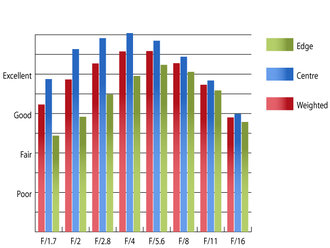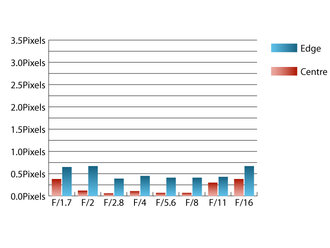Panasonic Leica DG Summilux 15mm f/1.7 Review
Panasonic Leica DG Summilux 15mm f/1.7 ASPH. Performance
Sharpness already approaches excellent levels in the centre of the frame at f/1.7, although typically of fast aperture lenses, the clarity towards the edges is only fairly good. Stopping down improves sharpness across the frame, with peak performance being achieved between f/4 and f/5.6. Here sharpness is outstanding in the centre and excellent towards the edges of the frame.
 MTF |
How to read our chartsThe blue column represents readings from the centre of the picture frame at the various apertures and the green is from the edges. Averaging them out gives the red weighted column.The scale on the left side is an indication of actual image resolution. The taller the column, the better the lens performance. Simple. For this review, the lens was tested on a Panasonic Lumix GX7 using Imatest. |
Chromatic aberrations are well controlled. Fringing is at its most prominent at f/1.7 and f/16, where it just exceeds half a pixel width. This low level of fringing should be difficult to spot, even in areas of high contrast towards the edges of the frame.
 CA |
How to read our chartsChromatic aberration is the lens' inability to focus on the sensor or film all colours of visible light at the same point. Severe chromatic aberration gives a noticeable fringing or a halo effect around sharp edges within the picture. It can be cured in software.Apochromatic lenses have special lens elements (aspheric, extra-low dispersion etc) to minimize the problem, hence they usually cost more. For this review, the lens was tested on a Panasonic Lumix GX7 using Imatest. |
Falloff of illumination towards the edges of the frame is typical for a lens sporting a fast maximum aperture. At f/1.7 the corners are 2.15 stops darker than the image centre and visually uniform illumination is achieved when stopped down to f/4 or beyond.
Distortion is very strong, which is disappointing performance for a prime lens. Imatest detected 6.15% barrel distortion, which may cause issues in images with straight lines parallel to the edges of the frame. Luckily the distortion pattern is uniform across the frame, so applying corrections in image editing software afterwards should be relatively straightforward.
No issues with flare were encountered during testing or loss of contrast, even when shooting into the light at maximum aperture. A deep, metal, circular hood is supplied with the lens, which does an excellent job of shading the lens from extraneous light that may cause issues, as well as protecting the lens from bumps and scrapes.
Value For Money
Being a freshly launched lens, the price is bound to settle down a little in time. Even so, it isn't overly expensive, being priced at around £525.Panasonic's own 14mm f/2.5 may be considered as an alternative to this lens. It is comparatively inexpensive, costing around £270 and sports a slimmer, pancake lens style design.
Add your message
Login required
Please login here or if you've not registered, you can register here. Registering is safe, quick and free.
Please login here or if you've not registered, you can register here. Registering is safe, quick and free.
photodo Stats
1102 lenses
428 MTF tests
74 in-depth photodo reviews
100+ users join each day
Help the lens community by reviewing or rating a lens today via our lens search
428 MTF tests
74 in-depth photodo reviews
100+ users join each day
Help the lens community by reviewing or rating a lens today via our lens search
Latest Lens Reviews
- Chinon 28mm f/2.8 Vintage Lens Review
- Canon EF 70-200mm f/4L IS II USM Lens Review
- Samyang AF 85mm f/1.4 EF Review
- Sigma 70mm f/2.8 DG Macro Art Review
- Samyang AF 24mm f/2.8 FE Review
- Meike 50mm f/1.7 Review
- Tamron 70-210mm f/4 Di VC USD Review
- Lensbaby Burnside 35mm f/2.8 Review
- Asahi Super Takumar 50mm f/1.4 Review
- Asahi Super-Multi-Coated Takumar 135mm f/3.5 Review
